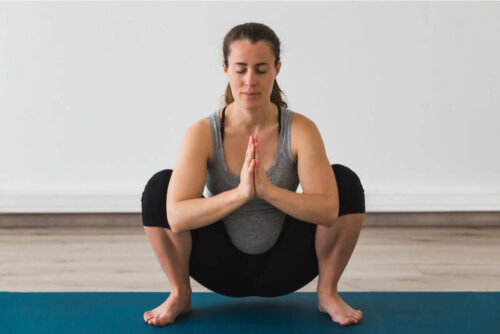The Pros and Cons of Sitting on the Floor

Sitting on the floor is quite good for you. After all, how much time do you spend in the chair every day? Probably a lot. In fact, it wouldn’t be hard to calculate how long you spend in that position, just do the math. As with everything, there are risks and benefits to both postures.
Yes, some people sit on the floor. There are even cultures and countries in which this position is normal. However, there’s a whole debate around posture and it’s important to break it down to better understand the best way for you.
The impact of sitting on a chair
Sitting has a huge impact on your health. Keep in mind that you’re using way less energy than when you’re in motion. It’s precisely for that reason that diseases such as obesity, hypertension, diabetes, and high cholesterol levels are associated with spending a lot of time in this position.
We need more studies but the evidence shows that moving is necessary, even if it’s low intensity. This is because it reduces the risk of major cardiovascular events, such as myocardial infarction or stroke.
The health benefits of sitting on the floor
There’s constant debate about sitting on the floor. It may not be comfortable at first, but it has a positive impact on the body. Let’s look at some of its benefits.
1. You’re more active
Sitting on the floor or squatting activates more muscles and prevents back pain. It isn’t the magic cure for lower back problems, but it does help, as long as you respect the straightness of the body axis.

2. The body’s anatomy indicates this is the best way to poop
Many, many people defend this statement. It makes sense as squatting allows a better angle between the large intestine, rectum, and anus. One that makes it easier to poop as it balances the position of the sphincter and the pelvic floor.
3. Recommended during the expulsion phase of childbirth
Squatting allows a greater opening for the passage of the baby. This position is one of the most used in the animal world at the time of delivery since the diameter of the pelvis expands more easily.
Not only that but gravity helps by being upright and decreases the efforts a woman must make to push. It also helps with the contractions as the position promotes the pressure of the fetus on the cervix, which contributes to an easier delivery. Another advantage is the soft tissue tears considerably reduce.
Learn about Six Great Techniques for Better Posture
4. It improves posture and neck pain
Squats help take the pressure off the neck because sitting on the floor keeps the connective tissues elastic and flexible. This, in contrast to sitting in a chair which stiffens them.
Things to consider when sitting on the floor
There are some drawbacks to sitting on the floor or in a squatting position as it can lead to certain types of problems to which you should pay attention. Let’s take a look.
1. Kneeling
This puts pressure on your knees and ankle joints. Thus, try getting down on one knee with one foot on the floor if you feel pain or numbness in your limbs.
2. Balancing while sitting on the floor
There’s less stability when kneeling since the buttocks remain above the floor. Hold on to a wall or sofa and change position if there’s pain or stability is an issue.
3. How to sit cross-legged
Sitting cross-legged can worsen problems, such as low back pain and poor posture. However, don’t slouch and keep your spine in a neutral position if you choose to do so. Put your weight on your hips instead of your feet.
Positions for sitting on the floor
There are several positions to sit on the floor to try and see if it’s something you’d like to do more often. Here are a few.
1. On your knees
Stand up, pass one leg behind your body, shifting your weight to the front leg. Slowly lower your back knee toward the floor and keep your toes on the floor with your ankle flexed.
Bring your shoulders over your hips and lower your front knee to the floor. Then, spread your knees shoulder-width apart and rest your buttocks on your heels.
2. Sitting on the floor cross-legged
Sit on the floor. Bend both knees and move outward. Place one foot under the opposite knee, then shift your weight to your hips instead of the feet. Your belly must be over your hips.
One way to decrease the pressure on the hips may be to sit on the edge of a folded blanket or on top of cushions.
3. Bent over sitting
This position can help with knee or ankle ailments. Try sitting on the floor, bending both knees, and planting your feet flat on the floor. Place your feet wider than hip-width apart and keep your belly over your hips.
4. Squat
Stand with your feet hip-width apart and place them flat on the floor, slowly lower your buttocks until they’re almost touching the floor. Keep your shoulders and chest upright.

Check out these Four Stretches that’ll Help Correct Your Posture
Are there any side effects of sitting on the floor?
As with everything, you should take precautions or practice with an awareness of the possible problems you may suffer from sitting on the floor. The weight of the body is centered on the lower extremities, so there’s pressure on the knees and ankles. In fact, this weight can decrease circulation in the lower extremities.
Have you any medical contraindications, such as problems in the hips, knees, and ankles? Then, it’s best not to sit on the floor. This is because doing so can further weaken the joints. Also, you’ll have trouble getting back up.
As you can see, sitting on the floor can be good for you if you know how to do it and maintain it as a good habit to take care of your body.
All cited sources were thoroughly reviewed by our team to ensure their quality, reliability, currency, and validity. The bibliography of this article was considered reliable and of academic or scientific accuracy.
- Laskowski E. ¿Cuáles son los riesgos de estar sentado mucho tiempo? [Internet]. Mayo Clinic. 21/08/2020 [Consultado 24/01/2021]. Disponible en https://www.mayoclinic.org/es-es/healthy-lifestyle/adult-health/expert-answers/sitting/faq-20058005
- Lugones M. El parto en diferentes posiciones a través de la ciencia, la historia y la cultura. Revista Cubana de Ginecología y Obstetricia 2012;38(1):134-145.
- Romero Añanca, Katia, and Milagros Yenifer Vargas Baca. “Relación entre los partos verticales y desgarros perineales en pacientes atendidas en el Centro de Salud de Belenpampa, enero a junio–2018.” (2018).
This text is provided for informational purposes only and does not replace consultation with a professional. If in doubt, consult your specialist.








